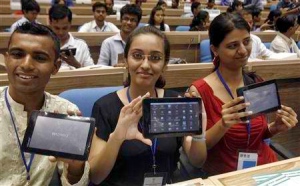The Aakash tablet was developed and manufactured by a British company called DataWind in partnership with the Indian government. The tablet will be available commercially for around 3000 rupees. The Indian Ministry of Education is buying some 100,000 tablets, subsidizing the costs so that they are available to students for about 1500 rupees, roughly $35.
Despite that low price-tag, the device is actually fairly powerful. It will run Android 2.2, although it does not have access to the official Android App Store (users will be able to access GetJar's app store instead). It has a 7-inch screen (it's resistive and doesn't have multitouch). It has a 366 MhZ processor and 256 MB RAM. There's 2 GB of flash memory (expandable up to 32 GB) and 2 USB ports. There are options to add a 3G card, but all the devices are all WiFi capable. The battery life, however, is its downfall: just three hours.
Clearly this is no iPad. But at $35, the stakes have changed. The price, along with the support from the Indian government, means that the Aakash tablet will be in the hands of thousands of Indian students. This gives them access to a mobile and Internet-ready device, which means users can browse the Web, use software applications, and access e-textbooks they never would have otherwise been able to afford.
With access to the Internet, e-books, and learning apps, it will be interesting to watch how devices like the Fire and the iPad will fare in the price wars against these kinds of low-cost tablets. Sure, they're probably faster and fancier, but in the long run, do they enable the same kind of easily accessible learning? And isn't that the point?
The manufacturer Datawind says it can produce about 100,000 units a month currently; that will barely scratch the surface of the demand -- even in India, where the government says it hopes to get all 220 million children online. It's part of a larger effort to boost literacy and graduation (both high school and college) rates in the country as well. The Guardian reports that the country has raised literacy rates to about 78% and has a goal of 30% enrollment in higher education by 2020. At this point, only about 7% of Indians graduate from high school.
As ThinkDigit observes, the Indian tablet market is actually seeing quite a bit of competition for these low-cost devices. Even though the iPad remains the dominant tablet worldwide, it's clear that there's a groundswell of interest and innovation around developing these tools to be far more affordable and accessible around the world. And it's possible, particularly now that people see the $35 tablet has been achieved, that others will be able to bring the price-tag even lower. As Datawind's CEO Suneet Singh Tuli noted, his company welcomes the competition to improve the product and drive prices down further.
"The intent is to start a price war. Let it start," Tuli told The Guardian, challenging others to build a better, cheaper device.


